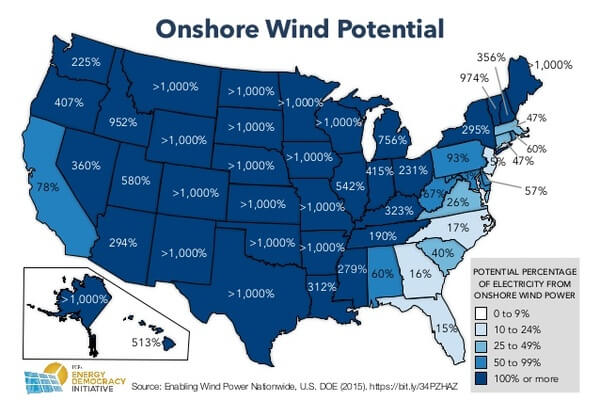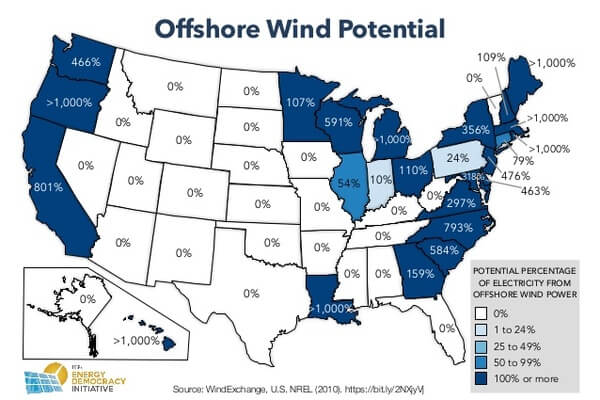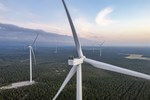News Release from windfair.net
Wind Industry Profile of
Self-Reliant U.S. States
It's a calculation of theoretical nature, but all the same it shows the potential of renewable energies: ten years ago, the Institute for Local Self-Reliance (ILSR) published the second edition of the Energy Self-Reliant States (ESRS), a first national overview of the state potential for renewable electricity in the U.S. According to the data, only 32 of 50 states were able to supply themselves with 100% renewable energy at that time. Many of these states had set a target of only 25% renewable electricity during this period.
Since then, the renewable energy sector has experienced rapid development. The technology has evolved, costs have fallen and knowledge of the threat posed by climate change has increased. As a result, the climate protection targets of many states and cities have become much more ambitious - quite a few now talk about 100% electricity from renewables.
A look at the ILSR's current data collection shows what is possible in 2020: onshore wind energy e.g. has tripled in the U.S. in the last ten years and now accounts for 7.3% of utilities' energy production. In view of its continuous technological improvement, onshore wind energy surpasses all other renewable energy sources in its net generation potential, and every single state has onshore wind resources.
As today's data show, 35 states can meet 100 percent of their energy needs with onshore wind power. The potential for self-sufficiency has risen sharply, especially in coastal states, as the map shows:

US states' onshore wind potential (Image: ILSR)
Over the last ten years, onshore wind has been increasingly joined by offshore wind energy. While the U.S. is still at the very beginning of this development, almost 30,000 megawatts have already been realised worldwide, mainly in Europe and China. The biggest advantage of offshore wind energy: constant wind speeds.
25 states in the U.S: have the potential for offshore wind generation, be it through an ocean or a lake. Of these states, 21 could generate more than 100 percent of their electricity consumption with offshore wind energy alone. Here, too, there is still enormous growth potential through further technological developments and cost reductions in the future, e.g. in the area of floating technology.

US states' offshore wind potential (Image: ILSR)
The ILSR study also shows the renewable power generation potential for rooftop solar, geothermal and hydro power for each individual state. Only free space solar wasn't included in the study. The individual maps can be viewed on the ILSR website. In conclusion, 47 out of 50 states could cover 100% of their electricity needs with domestic renewable energy.
Of course, there is a major catch to the study, because it only uses data from various sources, but doesn't include other decisive factors: thus politics supporting the growth of renewable energy must always be seen as a basic prerequisite. If this isn't the case at federal or state level, the states alone will not be able to realise their potential.
- Author:
- Katrin Radtke
- Email:
- press@windfair.net
- Keywords:
- USA, state, onshore, offshore, electricity, renewable energy, solar, hydro, self-reliant, ILSR


























